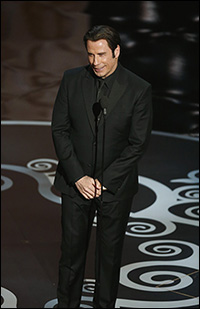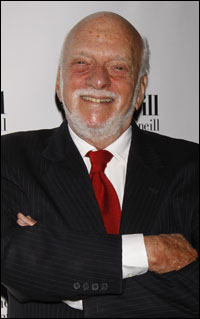
*
Harold Prince knows ‘em when he sees ‘em, so if he sees “a theatre giant” in 5’1½” Pat Birch as he says he does, believe it. Certainly, he’s used her enough to choreograph and, in his view, characterize his shows (Exhibits A-F: A Little Night Music, Candide, Pacific Overtures, Roza, Parade and Lovemusik). “Her great gift is to choreograph character so it isn’t just dancing–it’s dancing as a particular human being.”
This pint-sized sparkplug of theatrical energy will be honored with The Douglas Watt Lifetime Achievement Award June 2 at NYU’s Skirball Center for the Performing Arts. As lifetimes go, that’s close to six decades of dance on Broadway and off and in every medium imaginable.
Unlike, say, Susan Stroman, who sticks to musical theatre (save for a film version of one of her shows), Birch goes after any medium that moves. “I don’t stay on course,” she’s the first to admit. “I think what I do best--and I could be all wrong because I don’t know what I do—is take pop forms and use them in the period I’m working.”
Still, you’d expect someone who learned her craft from the mother of modern dance, Martha Graham, not to hang out on “Boardwalk Empire,” or do Carly Simon videos, or animate the William Bolcom opera of Robert Altman’s A Wedding, or set Steve Martin and Gilda Radner twirling to “Dancing in the Dark” on “Saturday Night Live.” The triumphs of this “Lefty”—the left-handed person who diversifies as opposed to the right-handed person who plays it safe and keenly focused—are apparent in the prizes she gets: two Emmys, two Drama Desk Awards, five Tony nominations.
Her hit of hits was Grease, the 15th longest-running Broadway show of all time and, in its time (1972-1980), the leader of the pack. She reprised her hard-driving rock ‘n’ roll gyrations for the film, then choreographed and directed its sequel, "Grease 2."
When the original publicist for Grease, Betty Lee Hunt, was asked to explain the success of Grease, she said with simplicity and finality that it was The Beat.
“Yes, there was that,” concedes Birch, who got maximum mileage out of that beat, “but I’ll really tell you what the audiences responded to—and I know this for a fact: It was the relationships. I don’t care where you went to school or when you went to school. In your class—think back—there was the fast girl, the leader of the gang, the kid who wanted to be part of everything, the nerd—they’re all there. We would do improvs about the prom, what it was like to have a date, what it was like not to.”
And, of course, Birch identified who was who by the character-signaling moves that they made. She set a whole generation of Broadway boppers into motion—in particular, Barry Bostwick, Adrienne Barbeau, Patrick Swayze, Treat Williams, Richard Gere, Judy Kaye, Nick Wyman, Randy Graff, Jeff Conaway, Ilene Graff, Peter Gallagher, David Paymer, Cynthia Darlow, Pippa Pearthree, Walter Charles, Kathi Moss and two who became Tony-winning directors, Walter Bobbie and Jerry Zaks.
| |
 |
|
| John Travolta |
Then, she and Grease director Tom Moore recast Travolta and Henner in “The Andrews Sisters musical,” a World War II homefront frolic called Over Here!
“That’s the show that put Annie Reinking and me on the map,” she remembers with an affectionate smile. “How often do you get a dancer like that or like John Mineo?”
A dancer-turned-choreographer like Birch, Reinking was artistic director for a senior arts program in Florida for 15 years, and Birch came down almost annually to work with the kids. “She said, ‘OK, we’re going to do ‘The Macarena,’" Reinking recalls, "but you’re going to be five nuns doing The Macarena, and you’re going to be five students from Harvard scullying and rowing down the river doing ‘The Macarena.’ Brilliant!”
After his two Broadway efforts, Travolta struck stardom in other mediums—first on television with “Welcome Back, Kotter,” then big-time in the movies with “Saturday Night Fever”—and he never returned to his stage roots. He followed “Fever” with the film version of Grease, conspicuously upgraded to the lead, with sufficient clout to hijack the “Greased Lightning” number away from Conaway’s character, Kenickie. But he didn’t get away with that without some permanent psychic damage. His most vivid memory of the filming, he has said, was Birch “trying to figure out what step in ‘Greased Lightning’ I would look best doing. She said, ‘You know, you have long arms like a monkey or a gorilla, so keep your arms hanging down like this.’ And it worked. It was kinda adolescent and kinda real, but I never forgot that I look like a gorilla.”
His co-star, Olivia Newton-John, was five years older than Travolta and a full decade out of high school—and only agreed to do the movie after she saw a screen test she insisted on making. She gives Birch points for her “amazing way of turning my natural rhythm into a dance routine and making it look like I really could do it.”
Stockard Channing, 33 at the time she played the racy Rizzo, has thanked Birch for “the dubious distinction of being the world’s oldest-living teenager” and, personally, for doing battle with producer Allan Carr to keep “that bumper ballad, ‘There Are Worse Things I Can Do,’” in the picture. Otherwise, “it never would have happened.”
Miraculously, Birch went from ‘50s rock directly into turn-of-the-(20th)-century three-quarter time, but she admits she “was terrified going into A Little Night Music. They wanted a big, long beginning—a sort of overture thing”—setting the delicate mood of the piece, so she brought the characters on in a graceful, hypnotic swirl.
Is Sondheim harder to choreograph than other composers? “Not necessarily,” she replies, “but you have got to be very, very careful so his words are heard. You have to find the moment to move people so that the lyric doesn’t get lost in the shuffle.”
| |
 |
|
| Harold Prince | ||
| Photo by Joseph Marzullo/WENN |
“It was hard. What did I know, except for a few Martha Graham steps that I now know were sort of around? The Graham vocabulary has a lot of Eastern stuff in it that I never understood until I did Overtures. ‘Oh, now I see where that came from.’”
Additional professional help was required. “I got a guy named Haruki Fujimoto—he did Commodore Perry’s ‘Lion Dance’ in the show—and took a bunch of lessons, me in a kimono with a fan looking like a Butterfly-on-a-bad-day, but I did learn enough.
“The Japanese TV people came over and shot Pacific Overtures, so there is a DVD. Hal saw it and sent a wonderful email, saying, ‘I’m thrilled at seeing what you did for us.’”
One of the little life-lessons that Birch picked up along the way: If you ever find yourself on foreign territory, do whatever you can—research, cajole, et al.—to improve your footing. “Martha Graham taught me that. Whenever she went to a new theatre, not only did she give the doorman a bottle of Scotch, she learned everybody’s name on the crew--so, before anything happened, she knew them by name. I’ve learned you listen to the crew and admit you don’t know when you don’t. The more you collaborate with them as people, the more it’s a joyous collaboration. They think they’re in it. I think I learned that from the Graham company when I was a kid. To sit there at her feet! All I wanted to do was get up there and dance. I didn’t want to hear about the poetry. I’m a lucky girl to have had that kind of background.” Her shakiest footing has been the Roaring rat-a-tat-tat ’20s of “Boardwalk Empire,” and she has been researching like mad the five seasons she has been doing it. (“Thank God for YouTube, among other things!”) Mostly, her work is confined to the nightclub floorshows that come up between shootouts. “The first year we had Babette’s, a Prohibition nightclub. Last year we had something like The Cotton Club called The Onyx Club, and I had 12 incredible black dancers. I got to pick ‘em.
“Scorsese directed the pilot, and said, ‘Do you want to do it?’ I said, ‘Course, I do.’ It may not be exactly a career move. It’s not my own show. It’s not a big deal for me, but I love doing it, and I love working with these people. They’re all absolutely tops.”
What thrills await her Monday night at The Astaire Awards, she has no idea—well, one idea: She is remounting for the event the “Moon-Faced, Starry-Eyed” number from Street Scene with Cory Lingner and Deanna Doyle. Assisting her is Daniel Levins, who danced it originally with Bronwyn Thomas and stopped the show cold in a production that she choreographed for longtime pal, director Jack O’Brien. “Jack and I had a mutual mentor—John Houseman,” she recalls as a grin forms. “Once, he directed an opera about the Hell’s Angels called The Losers. I’ll never forget him standing up, saying, ‘All the rapees to the right. All the rapists to the left.’
“He didn’t like the motorcycle ballet I did, and he said the most valuable thing to me: ‘We’re not going to talk about what we did. We are going to talk about what we will do.’ I wish we had that kind of—well, we do have a few giants left, but not like that.”
Yes. Some of the giants now are just 5’1½”.









